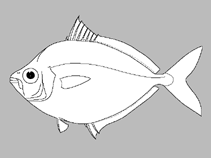Deveximentum mazavasaoka (Baldwin & Sparks, 2011)
Upload your photos and videos
Google imageNo image available for this species;
drawing shows typical species in Leiognathidae.
Google imageNo image available for this species;
drawing shows typical species in Leiognathidae.
Classification / Names Common names | Synonyms | Catalog of Fishes(genus, species) | ITIS | CoL | WoRMS | Cloffa
Teleostei (teleosts) > Acanthuriformes (Surgeonfishes) > Leiognathidae (Slimys, slipmouths, or ponyfishes) > Gazzinae
Environment: milieu / climate zone / depth range / distribution range Ecology
Marine; demersal. Tropical; 12°S - 19°S, 32°E - 50°E
Distribution Countries | FAO areas | Ecosystems | Occurrences | Point map | Introductions | Faunafri
Indian Ocean: South Africa to Mozambique. Known range extends from eastern coast of Africa (from east coast of South Africa and northward to coastal waters of Mozambique), throughout coastal Madagascar, and to the Mascarene islands.
Size / Weight / Age
Short description Identification keys | Morphology | Morphometrics
Together, the new species, S. indicius, and S. insidiator are readily distinguished from all congeners except S. hanedai by a more elongate (depth 40.5–57.7% SL) and essentially oval-shaped body (vs. deep and diskshaped in S. ruconius and S. interruptus [depth 53.4–65.5% SL], and S. megalolepis [depth 58.6–62.6% SL]). The new species is distinguished from S. hanedai by the presence of scales on the chest (vs. chest asquamate), and from S. indicius by an overall deeper (depth 47.3–57.7% SL), hatchet-shaped body (vs. body oval, depth 40.5–48.3% SL in S. indicius), and by pigmentation pattern on the dorsal flank comprising eight to eleven well-defined columns of irregular small spots and blotches (vs. 14 to 17 thin columns of spots or vertical lines in S. indicius). The new species is distinguished from S. insidiator by an overall more hatchet-shaped body (vs. body oval and evenly rounded ventrally in S. insidiator), dorsal pigmentation pattern as described above (vs. larger, irregular blotches inpoorly defined columns in S. insidiator), a strongly upturned mouth and compressed pug-like snout, and dorsal-fin insertion well posterior of vertical through pectoral-fin base (vs. about level of pectoral-fin base in S insidiator) (Ref. 87758).
Life cycle and mating behavior Maturity | Reproduction | Spawning | Eggs | Fecundity | Larvae
Main reference
Upload your references | References | Coordinator : Woodland, David J. | Collaborators
Baldwin, Z.H. and J.S. Sparks, 2011. A new species of Secutor (Teleostei: Leiognathidae) from the Western Indian Ocean. Zootaxa 2998:39-47. (Ref. 87758)
CITES
Not Evaluated
Threat to humans
Harmless
Human uses
FAO - Publication: search | FishSource |
More information
Trophic ecology
Food items
Diet composition
Food consumption
Food rations
Predators
Food items
Diet composition
Food consumption
Food rations
Predators
Ecology
Ecology
Ecology
Population dynamics
Growth parameters
Max. ages / sizes
Length-weight rel.
Length-length rel.
Length-frequencies
Mass conversion
Recruitment
Abundance
Growth parameters
Max. ages / sizes
Length-weight rel.
Length-length rel.
Length-frequencies
Mass conversion
Recruitment
Abundance
Life cycle
Reproduction
Maturity
Maturity/Gills rel.
Fecundity
Spawning
Spawning aggregations
Eggs
Egg development
Larvae
Larval dynamics
Reproduction
Maturity
Maturity/Gills rel.
Fecundity
Spawning
Spawning aggregations
Eggs
Egg development
Larvae
Larval dynamics
Anatomy
Gill area
Brain
Otolith
Gill area
Brain
Otolith
Physiology
Body composition
Nutrients
Oxygen consumption
Swimming type
Swimming speed
Visual pigments
Fish sound
Diseases & Parasites
Toxicity (LC50s)
Body composition
Nutrients
Oxygen consumption
Swimming type
Swimming speed
Visual pigments
Fish sound
Diseases & Parasites
Toxicity (LC50s)
Genetics
Genetics
Heterozygosity
Heritability
Genetics
Heterozygosity
Heritability
Human related
Aquaculture systems
Aquaculture profiles
Strains
Ciguatera cases
Stamps, coins, misc.
Aquaculture systems
Aquaculture profiles
Strains
Ciguatera cases
Stamps, coins, misc.
Tools
E-book | Field guide | Length-frequency wizard | Life-history tool | Point map | Classification Tree
| Catch-MSY |
Special reports
Download XML
Internet sources
AFORO (otoliths) | Aquatic Commons | BHL | Cloffa | BOLDSystems | Websites from users | Check FishWatcher | CISTI | Catalog of Fishes: genus, species | DiscoverLife | ECOTOX | FAO - Publication: search | Faunafri | Fishipedia | Fishtrace | GenBank: genome, nucleotide | GloBI | Google Books | Google Scholar | Google | IGFA World Record | MitoFish | Otolith Atlas of Taiwan Fishes | PubMed | Reef Life Survey | Socotra Atlas | Tree of Life | Wikipedia: Go, Search | World Records Freshwater Fishing | Zoological Record
Estimates based on models
Phylogenetic diversity index (Ref. 82804): PD50 = 0.5078 [Uniqueness, from 0.5 = low to 2.0 = high].
Bayesian length-weight: a=0.01905 (0.00853 - 0.04255), b=2.95 (2.76 - 3.14), in cm total length, based on LWR estimates for this (Sub)family-body shape (Ref. 93245).
Trophic level (Ref. 69278): 2.7 ±0.3 se; based on size and trophs of closest relatives
Resilience (Ref. 120179): High, minimum population doubling time less than 15 months (Preliminary K or Fecundity.).
Fishing Vulnerability (Ref. 59153): Low vulnerability (10 of 100).




